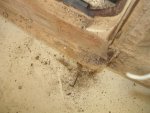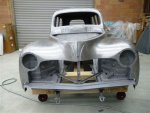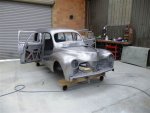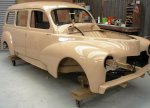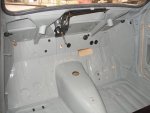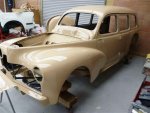It's probably time for me to expose this job to the World. But first, I need to make clear where I am coming from in order not to offend many of the 203 punters who frequent this site.
It has long been my opinion that no-one in Australia so far has attempted a 203 restoration that seeks to ensure that the subject vehicle emerges authentic in all parts, including fasteners. What I have started with is a relatively rare version of the 203 wagon which was largely unmolested, rust free (yes-you read right) and, I believe, low mileage. From this base I felt a strong obligation to ensure that as much originality as possible is preserved while removing the daggy bits.
The story starts in 1973 when I purchased the wagon from a slightly dodgey dealer in lower priced used cars. It had apparently been used as a surf wagon, being fitted with curtains, filled with beach sand and had holes where a stereo previously resided. The radiator showed signs of recent overheating with a stretched top tank and a neat hole drilled in the cap to relieve pressure. The dealer assured me that a new head gasket had been fitted and all was well. A price of $150 was negotiated. ACT registration was obtained after a new tail pipe was fitted. A vicious underfloor knocking was cured by tightening the upper gearbox mount bolt and four cylinders restored by a new set of plugs. It can be very hard getting across an intersection in a healthy 203 - one running on two cylinders is usually beaten by the change of lights!
The wagon provided useful second car transport for a couple of years until power started to drop off. A tear down revealed that all the rings had broken into small pieces, tearing out the piston lands. The direct metal big ends also showed bad wear, despite the crankshaft being within tolerance. My thoughts were that the previous surfie owner had probably pulled it out of a shed and roared the crap out of it without changing the oil.
Needing a replacement, I sold it to a friend and bought a 1955 203C5 wagon (very rusty and another story), Said friend fitted new rings on second hand pistons, shell big end conrods and new mains. He drove it 100 miles to his shed where it rested from 1976 to 2009.
By about 2008 I had developed a longing for another 203. Realising that original and rust free examples were virtually non-existant my thoughts returned to the wagon. Yes, it was for sale and a deal done. The attached photos show its retrieval and state after washing. The whole was sound but very tired. All rubber was unusable and the pee of a thousand rats and possums had promoted a great deal of surface rust.
A few details. It's a 203U6A with a C2 gearbox, an interim model made between June and September 1954. Given that the serial number is 900+ on from June 1954, the CKD kit probably left France during that month. Australian assembly was by NSW distributors, Harden and Johnston.
Restoration proper commenced on my retirement in January 2011. This has consisted so far of total stripdown, sourcing parts from France and elswhere, abrasive blasting and repainting. More pictures to come in future posts.
Tony
It has long been my opinion that no-one in Australia so far has attempted a 203 restoration that seeks to ensure that the subject vehicle emerges authentic in all parts, including fasteners. What I have started with is a relatively rare version of the 203 wagon which was largely unmolested, rust free (yes-you read right) and, I believe, low mileage. From this base I felt a strong obligation to ensure that as much originality as possible is preserved while removing the daggy bits.
The story starts in 1973 when I purchased the wagon from a slightly dodgey dealer in lower priced used cars. It had apparently been used as a surf wagon, being fitted with curtains, filled with beach sand and had holes where a stereo previously resided. The radiator showed signs of recent overheating with a stretched top tank and a neat hole drilled in the cap to relieve pressure. The dealer assured me that a new head gasket had been fitted and all was well. A price of $150 was negotiated. ACT registration was obtained after a new tail pipe was fitted. A vicious underfloor knocking was cured by tightening the upper gearbox mount bolt and four cylinders restored by a new set of plugs. It can be very hard getting across an intersection in a healthy 203 - one running on two cylinders is usually beaten by the change of lights!
The wagon provided useful second car transport for a couple of years until power started to drop off. A tear down revealed that all the rings had broken into small pieces, tearing out the piston lands. The direct metal big ends also showed bad wear, despite the crankshaft being within tolerance. My thoughts were that the previous surfie owner had probably pulled it out of a shed and roared the crap out of it without changing the oil.
Needing a replacement, I sold it to a friend and bought a 1955 203C5 wagon (very rusty and another story), Said friend fitted new rings on second hand pistons, shell big end conrods and new mains. He drove it 100 miles to his shed where it rested from 1976 to 2009.
By about 2008 I had developed a longing for another 203. Realising that original and rust free examples were virtually non-existant my thoughts returned to the wagon. Yes, it was for sale and a deal done. The attached photos show its retrieval and state after washing. The whole was sound but very tired. All rubber was unusable and the pee of a thousand rats and possums had promoted a great deal of surface rust.
A few details. It's a 203U6A with a C2 gearbox, an interim model made between June and September 1954. Given that the serial number is 900+ on from June 1954, the CKD kit probably left France during that month. Australian assembly was by NSW distributors, Harden and Johnston.
Restoration proper commenced on my retirement in January 2011. This has consisted so far of total stripdown, sourcing parts from France and elswhere, abrasive blasting and repainting. More pictures to come in future posts.
Tony

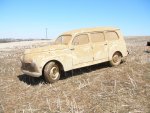
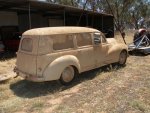
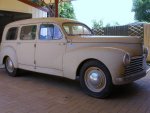
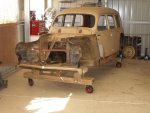
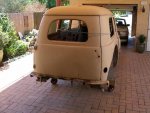

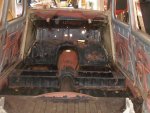
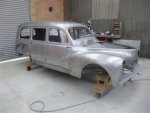
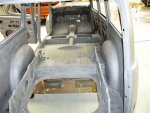
 wish to sell after you've done all the hard work of course!
wish to sell after you've done all the hard work of course!